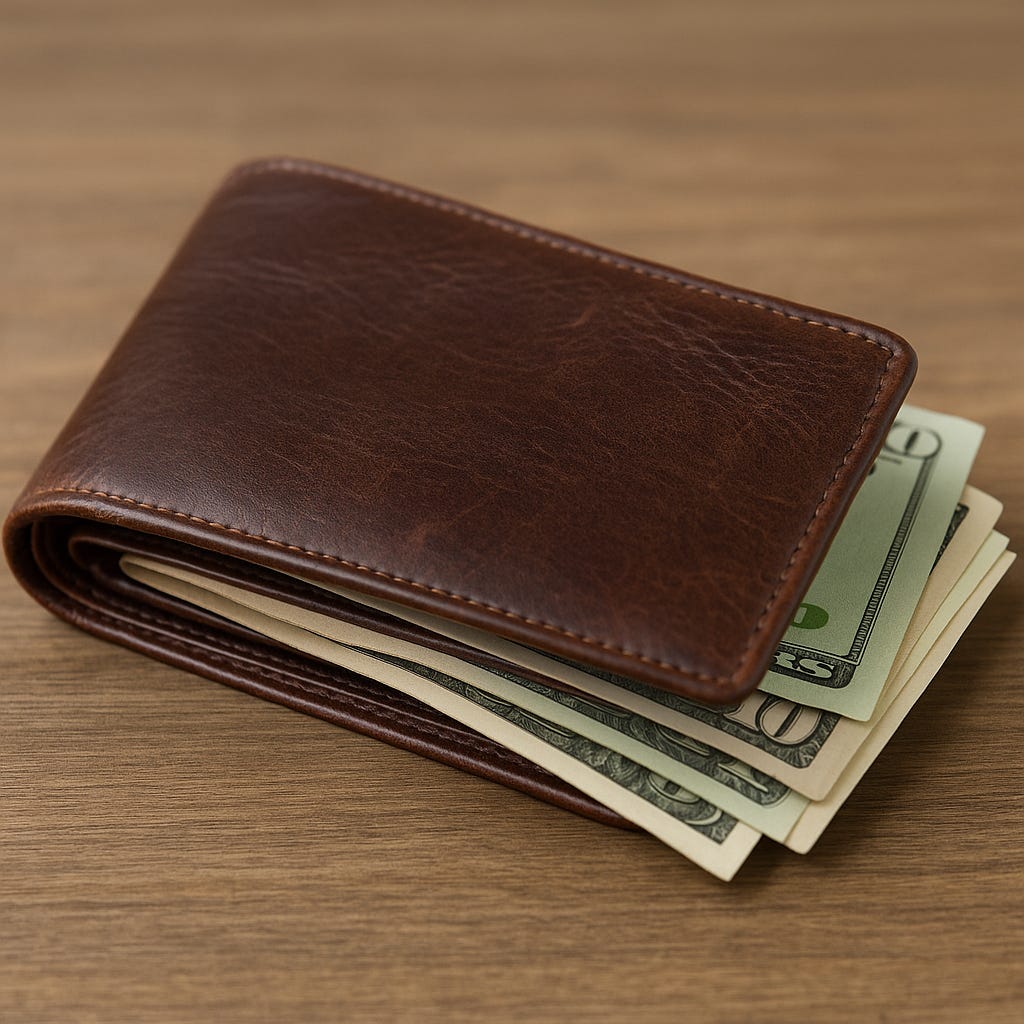WHAT'S LEFT IN YOUR WALLET?
Core inflation may be steady, but my grocery bill isn’t.
I had $60 in my wallet until I went to the gas station. I pay cash because (I’m cheap), I s
ave 35 cents a gallon by not using my debit card. Hey, over a year, that adds up, you know?
My gas tank sucked up every bit of that $60, and I’m pretty sure it would’ve taken more if I’d let it.
Next stop: Walgreens, three prescriptions, $34. Just think what they’d cost without Medicare or decent insurance.
Walmart: $14.
Trader Joe’s: $18.
It cost me $126 just to walk out the door today, and none of it was optional.
That’s my personal inflation rate.
According to the Bureau of Labor Statistics, the “core” inflation rate, which excludes food and energy, was 3.0% for the 12 months ending in September 2025. Food prices were up 3.1%, a small drop from August’s 3.2%. Energy rose more sharply, from 0.2% in August to 2.8% in September.
If you listen to the experts, they’ll tell you inflation is “moderating.” That may be true on paper, but my wallet didn’t get the memo. Let’s break down what’s really driving the numbers behind those receipts I racked up today.
1. Supply and production costs.
It’s gotten more expensive to make, ship, and stock nearly everything. Factories still face higher costs for raw materials. Shipping containers that used to cost $2,000 can run $6,000 or more. And when gas or diesel prices rise, so does the cost of getting lettuce to the grocery shelf or medicine to the pharmacy. Companies don’t/won’t swallow those costs; they pass them on to us.
2. Demand overload.
After the pandemic, people wanted to spend again, travel, eat out, fix their homes. That surge of buying power created what economists call demand-pull inflation, meaning too many people chasing too few goods. When everyone wants the same thing, the price tag climbs. Even now, strong consumer spending keeps prices from falling back to “normal.”
3. Energy and food volatility.
Fuel and groceries are the heartbeat of our daily life, and the wild cards of inflation. Energy prices swing fast depending on global events, weather, and production. Food costs shift with droughts, storms, and shipping costs. When these two rise, everything from bread to bus fares inches higher.
So yes, the Bureau of Labor Statistics says “core inflation” is steady at 3%. But when the basics, food, gas, and medicine, are part of your daily routine, the numbers don’t tell the whole story.
Eggs are no longer the villain at the market. These days, you can pull anything from a shelf or bin and wince at the price, right?
When I open my refrigerator door now, it always looks empty. I used to keep doubles of our essentials, orange juice, butter, jelly, and cheese, so I wouldn’t have to run to the market every day. (I still do anyway.)
I’ve also stopped buying paper goods in bulk. I’ll grab one six-roll pack of paper towels instead of the mega bundle, because right now, it’s cheaper, and it keeps more money in my pocket. In other words, I don’t want my money sitting on the shelf; I want it where I can reach it.
Food prices have changed and so has what’s in my market basket. Red meat is sky-high, so we eat more fish, chicken, and pork, with a splurge-worthy ribeye maybe once every few weeks.
Could you say inflation is keeping us healthy? Maybe. But it sure doesn’t make dinner taste any cheaper.
I was raised on name brands, in canned goods, cleaning supplies, and frozen foods. These days, I’m experimenting with store brands, and so far, all’s good.
I no longer buy clothes or accessories just because. When I do decide to make a purchase, I wait 24 hours. It works! Most of the time, I’m not as crazy about whatever it was, and the urge passes.
We all know there are plenty of other corners we could cut, but hey, baby steps.
What about you? What’s changed in your own spending? Has it made a difference? Drop me a note, I’m always looking for a good deal (and a good story).
